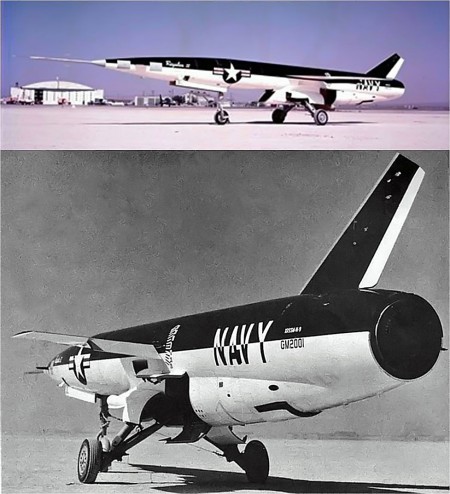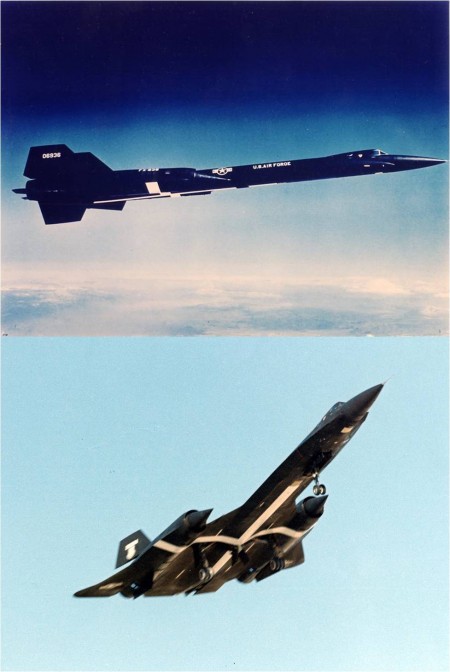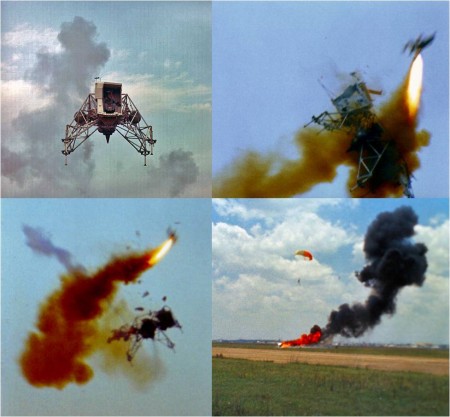
Fifty-seven years ago this week, the United States Navy successfully conducted the first flight test of the Chance Vought Regulus II cruise missile. This initial test departed from and recovered to Rogers Dry Lake at Edwards Air Force Base, California.
The Regulus II was designed as the supersonic follow-on to the Navy’s Regulus I ship-launched cruise missile. Utilizing an inertial reference system, the Regulus II was autonomously guided to the target. This represented a great improvement over Regulus I which employed a more primitive radio command guidance system.
Like its Regulus I forebear, Regulus II featured an airplane-like external airframe configuration and cruised under turbojet power. The vehicle was rocket-launched to the turbojet takeover speed (300 knots) using the Zero-Length Launch (ZLL) concept. The single rocket booster generated 115,000 lbs of thrust for 4 seconds and was jettisoned following burnout.
The Regulus II missile engineering and development effort saw the missile built in three (3) airframe blocks. The flight test version was designated as XRSSM-N-9 and included seven (7) airframes (GM-2001 to GM-2007). The fleet training variant was designated as XRSSM-N-9A, of which twenty-nine (29) were built (GM-2008 to GM-2036).
The Regulus II tactical missile, designated XSSM-N-9, included thirty-eight (38) airframes (GM-3001 to GM-3038). It measured 67 feet in length and featured a wingspan of 20.75 feet. Gross Take-Off Weight (GTOW) and empty weight were 21,300 lbs and 11,690 lbs, respectively. Power was provided by a General Electric J79 afterburing turbojet.
As originally designed, Regulus II was intended to cruise 1,000 nm at Mach 0.94 and an altitude of 32,000 feet. This range fell to 600 nm at a cruise altitude of 5,000 feet. For a supersonic cruise at Mach 2 and 65,000 feet, the vehicle had design range of 635 nm.
Initial flight testing of the Regulus II missile did not use the rocket booster. Rather, the vehicle became airborne via a normal runway take-off. The missile was remotely controlled by a pilot flying alongside in a two-place control aircraft. In this case, the aircraft was a TV-2D; a modified version of the Lockheed T-33. The front-seater flew the Regulus II while the back-seater flew the control airplane. Chase support was provided by Douglas F4D Skyray and Vought F8U Crusader aircraft.
Airframe GM-2001 made the first test flight of a Regulus II vehicle at Edwards Air Force Base, California on Tuesday, 29 May 1956. The first XRSSM-N-9 departed Rogers Dry Lake at 14:11 UTC following a take-off roll of slightly over 12,000 feet. The missile quickly accelerated to 356 knots as it climbed to an altitude of nearly 11,000 feet. Amazingly, all major missile systems performed nominally during the nearly 33-minute test hop and GM-2001 landed safely back on the dry lake bed.
The Navy would go on to conduct forty-seven (47) more Regulus II flight tests through November 1958. These tests were successful in the main and the Regulus II system performed well overall. However, the emergence of the contemporaneous and superior UGM-27 Polaris Submarine-Launched Ballistic Missile (SLBM) rendered the Regulus II missile obsolete. As a result, the Navy cancelled the Regulus II Program in December 1958.

Forty-eight years ago this month, the USAF/Lockheed YF-12A set a bevy of world speed and altitude peformance records. A pair of aircraft and a team of five USAF aircrew flew these missions which originated out of Edwards Air Force Base, California.
The YF-12A was the interceptor variant of the vaunted Lockheed A-12 Mach 3+ aircraft. Armed with a quartet of Hughes AIM-47A air-to-air missiles, the YF-12A’s mission would be to intercept and destroy incoming Soviet bombers. Lockheed proposed the A-12 variant as a cost-effective replacement for the defunct North American XF-108 Rapier.
The YF-12A differed from the A-12 in that a second crew station was added for the AIM-47A Weapons Systems Officer (WSO). The WSO operated the powerful Hughes AN/ASG-18 fire control radar which had a range on the order of 500 miles. The YF-12A’s forebody chines were truncated back of the axisymmetric nose to accommodate the radar system. Infrared (IR) sensors were installed on the leading edges of the shortened chines.
The Hughes AIM-47A missile measured 12.5 feet in length and 13.5 inches in diameter. Maximum range of the 800-pound missile was in excess of 100 miles. While the type’s intended maximum Mach number was 6, propulsion system development problems limited the demonstrated maximum Mach number to 4. About eighty (80) AIM-47A missiles were produced. Seven (7) of these rounds were test fired in flight. All but one (1) was successful.
Lockheed converted a trio of A-12 aircraft to the YF-12A configuration. The YF-12A aircraft were assigned serial numbers 60-6934 (Ship 1), 60-6935 (Ship 2) and 60-6936 (Ship 3). Ship 1 made the maiden YF-12A flight from Groom Lake, Nevada on Wednesday, 07 August 1963 with James D. Eastham at the controls.
On Saturday, 01 May 1965, YF-12A aircraft 60-6934 and 60-6936 were flown by a quintet of USAF aircrew in an impressive demonstration of the interceptor’s altitude and speed performance. These missions were conducted by the Air Force Flight Test Center (AFFTC) at Edwards Air Force Base, California. Specifically, the following FAI-certified Class C Group III absolute performance records were established on that day:
Sustained Altitude (Absolute): 80,258 feet
Aircraft: YF-12A, Ship 1 (Serial Number 60-6934)
Aircrew: Col Robert L. Stephens/Lt Col Daniel Andre
15/25 km Closed-Circuit (Absolute): 2,070.102 mph
Aircraft: YF-12A, Ship 3 (Serial Number 60-6936)
Aircrew: Col Robert L. Stephens/Lt Col Daniel Andre
500 km Closed-Circuit (Class C): 1,643.042 mph
Aircraft: YF-12A, Ship 3 (Serial Number 60-6936)
Aircrew: Maj Walter F. Daniel/Maj Noel T. Warner
1,000 km Closed-Circuit, No Payload: 1,688.891 mph
Aircraft: YF-12A, Ship 3 (Serial Number 60-6936)
Aircrew: Maj Walter F. Daniel/Capt James P. Cooney
1,000 km Closed-Circuit, 1,000 kg Load (Absolute): 1,688.891 mph
Aircraft: YF-12A, Ship 3 (Serial Number 60-6936)
Aircrew: Maj Walter F. Daniel/Capt James P. Cooney
1,000 km Closed-Circuit, 2,000 kg Load (Class C): 1,688.891 mph
Aircraft: YF-12A, Ship 3 (Serial Number 60-6936)
Aircrew: Maj Walter F. Daniel/Capt James P. Cooney
USAF liked the YF-12A’s demonstrated performance capabilities. Thus, on Friday, 14 May 1965, the service ordered ninety-three (93) units of the production YF-12A aircraft known as the F-12B. Congress approved the order and allotted $90M to get production going. Unfortunately, United States Secretary of Defense Robert S. McNamara nixed the deal and cancelled the production of the F-12B.
Following the F-12B cancellation, YF-12A flight testing by USAF continued through 1969. One aircraft was lost along the way. On Thursday, 14 August 1966, Ship 1 was severely damaged in a landing incident at Edwards AFB and never flew again. Fortunately, the crew escaped with their lives.
In December of 1969, NASA initiated a flight research effort using YF-12A Ship 2 and Ship 3. Over the next ten (10) years a wealth of aerodynamic, aero heating, structural and propulsion flight research data were acquired using these unique high-speed assets. A great benefit in this regard was the type’s ability to sustain Mach 3+ flight conditions for periods up to 15 minutes per mission.
YF-12A Ship 3 was lost on Thursday, 24 June 1971 when an inflight fire started due to a failed fuel line in the right-hand J58 turbo-ramjet engine. The USAF crew of pilot Lt Col Ronald J. Layton and WSO Maj William A. Curtis attempted to recover the aircraft to Edwards AFB. However, the fire quickly spread and forced the crew to abandon the aircraft. They ejected safely and survived. Ship 3 was making its 67th flight of the NASA YF-12A flight research effort at the time of its demise.
Following Ship 3′s loss, Ship 2 flew the remainder of the NASA YF-12A high-speed flight research program. It registered a total of 146 missions in that capacity. On Wednesday, 07 November 1979, YF-12A Ship 2 departed Edwards AFB for its final destination; the USAF Musuem at Wright-Patterson AFB, Ohio. The USAF crew consisted of pilot Col James V. Sullivan and USAF Museum Director Richard Uppstrom as the guy in back (GIB).
The only YF-12A aircraft to survive the USAF and NASA flight programs was Ship 2. That aircraft (60-6935) is currently on display in the Research and Development Gallery at the United States Air Force National Museum in Dayton, Ohio. Also displayed there is the 1965 Thompson Trophy that was awarded to Col Robert L. Stephens and Lt Col Daniel Andre for their record-setting YF-12A flight of 2,070.102 mph.

Forty-nine years ago today, NASA successfully tested the Apollo Launch Escape System (LES) during a simulated abort of a boilerplate Apollo Command Module (CM). The mission was the second of six test shots aimed at demonstrating that the LES could safely abort the CM under critical ascent flight conditions.
The Apollo Launch Escape System (LES) was designed to provide a positive means of crew esacpe in the event of booster failure during the early stages of ascent. The LES incorporated a trio of solid rocket motors: the launch-escape motor, the tower-jettison motor, and the pitch-control motor. The primary and largest rocket motor of the three was the launch-escape motor which generated 155,000 lbs of thrust.
NASA’s Little Joe flight test program involved the abort testing of boilerplate Apollo Command Modules using Little Joe II launch vehicles. The purpose of the subject test series was to examine the performance of the Apollo CM and LES under highly stressing flight conditions. The Little Joe flights were flown out of White Sands Missile Range (WSMR) between November 1963 and January 1966.
The Apollo Little Joe flight test series consisted of a pair of Pad Abort (PA) tests and a quartet of ascent abort (AA) tests. Each PA mission involved flying a LES-CM combination to simulate an on-the-pad abort. Such would be the case, for instance, should a Saturn launch vehicle explode on the launch pad. The AA missions utilized Little Joe II launch vehicles to test the LES-CM at critical abort mode flight conditions.
Designated Abort Missions A-001 through A-004, the AA flight tests examined performance of the LES and CM under the following abort flight conditions: Transonic Abort (A-001), Maximum Dynamic Pressure Abort (A-002), Low-Altitude Abort (A-003) and Power-on Tumbling Boundary Abort (A-004).
The first of the AA missions (A-001) was launched from White Sands Missile Range, New Mexico at 12:59:59 UTC on Wednesday, 13 May 1964. At an altitude of 15,400 feet during the ascent, the Little Joe II was intentionally self-destructed. The LES fired as designed and propelled the Apollo CM boilerplate to 29,772 feet. At this point, the 3-phase (drogue, pilot and main) parachute recovery system deployed and soft-landed the CM at a sink rate of 26 feet/second. Total flight time from ignition to touchdown was 350 seconds.
Mission A-001 was entirely successful. The LES worked as advertised and the boilerplate Apollo CM test article survived the transonic abort test in good shape. The only anomaly noted was the collapse of one of the three main parachutes due to a broken riser. Since the Apollo CM was designed to land safely on only two main parachutes, the collapsed parachute anomaly was not considered an issue.
History records that the A-002, A-003 and A-004 abort missions were subsequently and successfully flown in December 1964, May 1965 and January 1966, respectively. Along with A-001, these missions helped qualify the Apollo LES and the CM earth landing system for manned missions. Post-flight analyses revealed that had these abort tests had been manned, the flight crew would have landed safely in all cases.

Forty-five years ago today, NASA Astronaut Neil A. Armstrong narrowly escaped with his life when he was forced to eject from the Lunar Landing Research Vehicle in which he was training. Armstrong punched-out only 200 feet above ground level and spent just 4 seconds in the silk before safely landing.
The Lunar Module (LM) was the vehicle used by Apollo astronauts to land on and depart from the lunar surface. This unique spacecraft consisted of separate descent and ascent rocket-powered stages. The powered descent phase was initiated at 50,000 feet AGL and continued all the way to landing. The powered ascent phase lasted from lunar lift-off to 60,000 feet AGL.
It was recognized early in the Apollo Program that landing a spacecraft on the lunar surface under vacuum conditions would be very challenging to say the least. To maximize their chances for doing so safely, Apollo astronauts would need piloting practice prior to a lunar landing mission. And they would need an earth-bound vehicle that flew like the LM to get that practice.
The Lunar Landing Research Vehicle (LLRV) was the answer to the above. The LLRV employed a turbojet engine that provided vertical thrust to cancel five-sixths of its weight since the gravity on the Moon is one-sixth that of Earth. The vehicle was also configured with dual lift rockets to provide vertical and horizontal motion. LLRV 3-axis attitude control was provided by a series of 16 small thrusters.
The LLRV was described by one historical NASA document as being “unconventional, contrary and ugly”. Known as the “Flying Bedstead”, the LLRV was designed for the specific purpose of simulating LM flight during the terminal phase of a lunar landing. The LLRV was not easy to fly in the “low and slow” flight regime in which it operated. The type was not eye-pleasing in the least.
A pair of LLRV’s were constructed by Bell Aerosystems and flight tested at what is now the NASA Dryden Flight Research Center starting in October 1964. These vehicles were subsequently shipped to Ellington Air Force Base in Texas by early 1967. A number of flight crew, including Neil Armstrong, began LLRV flight training shortly thereafter.
Neil Armstrong made his first LLRV flight on Monday, 27 March 1967 in LLRV No. 1. (This occurred two months after the horrific Apollo 1 Fire.) Armstrong continued flight training in the LLRV over the next year in preparation for what would ultimately be the first manned lunar landing attempt in July of 1969
On Monday, 06 May 1968, Armstrong was flying LLRV No. 1 when the vehicle began losing altitude as its lift rockets lost thrust. Using turbojet power, Armstrong was able to get the LLRV to climb. As he did so, the vehicle made an uncommanded pitch-up and roll over. The attitude control system was unresponsive. The pilot had no choice but to eject.
Neil Armstrong ejected from the LLRV at 200 feet AGL as LLRV No. 1 crashed to destruction. The pilot was subjected to an acceleration of 14 G’s as his rocket-powered, vertically-seeking ejection seat functioned as designed. Armstrong got a full chute, but made only a few swings in same before safely touching-down back on terra firma. His only injury was to his tongue, which he accidently bit at the moment of ejection seat rocket motor ignition.
A mishap investigation board attributed the LLRV mishap to a design deficiency that allowed the helium gas pressurant of the lift rocket and attitude control system fuel tanks to be be accidently depleted. Thus, propellants could not be delivered to the lift rockets and attitude control system thrusters.
Neil Armstrong and indeed all of the Apollo astronauts who landed on the Moon trained in improved variants of the LLRV known as the Lunar Landing Training Vehicle (LLTV). This training was absolutely crucial to the success of the half-dozen Apollo crews who landed on the Moon. Indeed, there was no other way to adequately simulate moon landings except by flying the LLTV.




